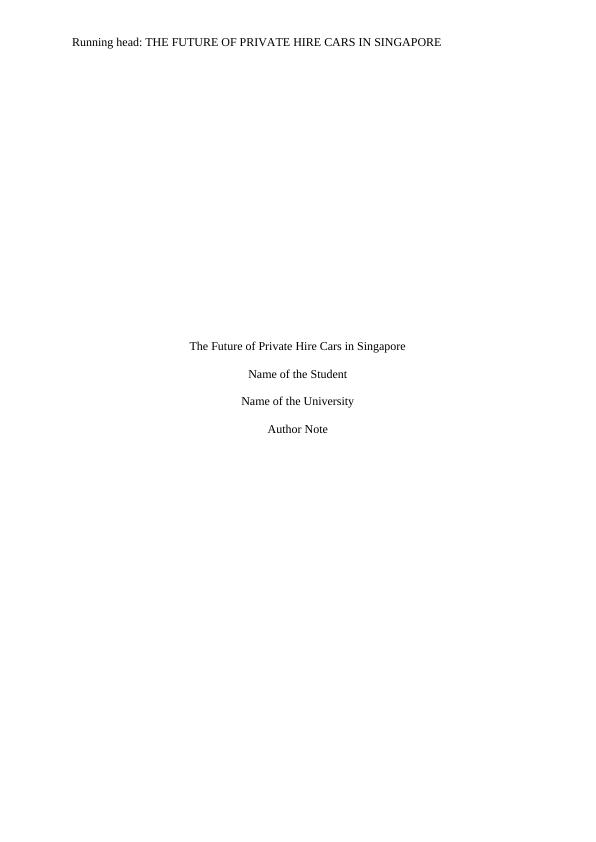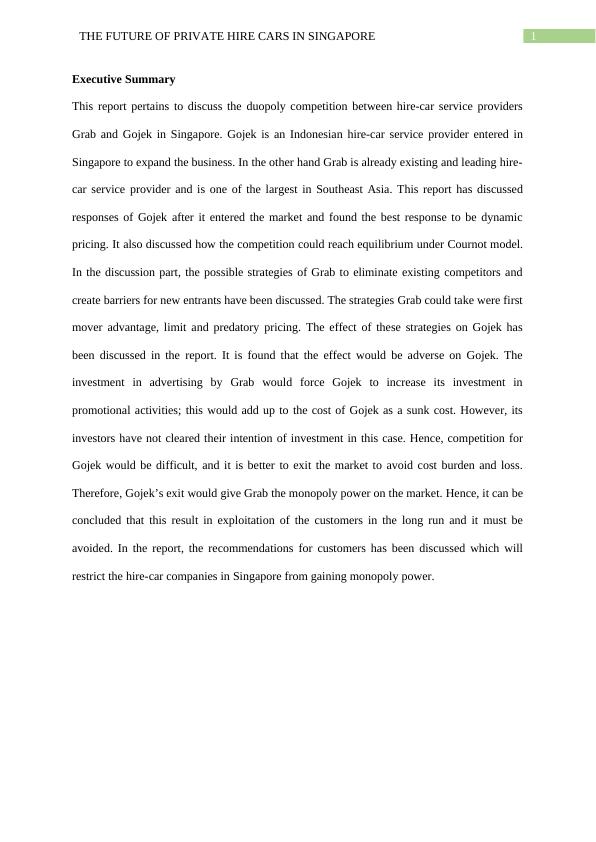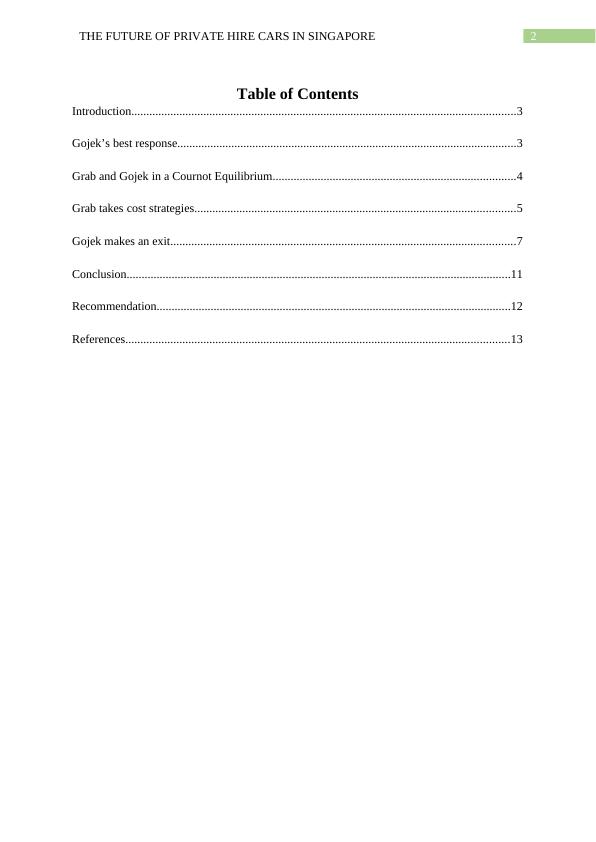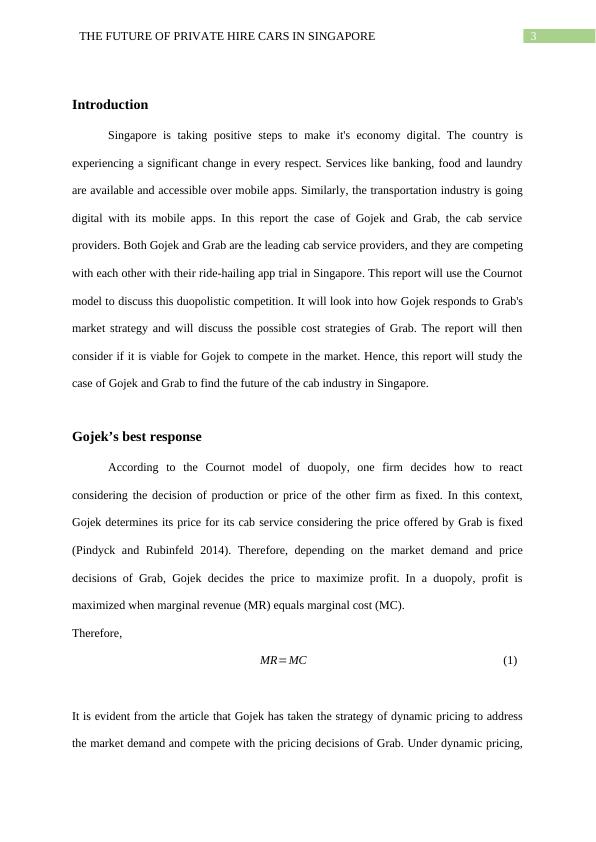The Future of Private Hire Cars in Singapore
Added on 2022-12-27
16 Pages4242 Words84 Views
Running head: THE FUTURE OF PRIVATE HIRE CARS IN SINGAPORE
The Future of Private Hire Cars in Singapore
Name of the Student
Name of the University
Author Note
The Future of Private Hire Cars in Singapore
Name of the Student
Name of the University
Author Note

THE FUTURE OF PRIVATE HIRE CARS IN SINGAPORE 1
Executive Summary
This report pertains to discuss the duopoly competition between hire-car service providers
Grab and Gojek in Singapore. Gojek is an Indonesian hire-car service provider entered in
Singapore to expand the business. In the other hand Grab is already existing and leading hire-
car service provider and is one of the largest in Southeast Asia. This report has discussed
responses of Gojek after it entered the market and found the best response to be dynamic
pricing. It also discussed how the competition could reach equilibrium under Cournot model.
In the discussion part, the possible strategies of Grab to eliminate existing competitors and
create barriers for new entrants have been discussed. The strategies Grab could take were first
mover advantage, limit and predatory pricing. The effect of these strategies on Gojek has
been discussed in the report. It is found that the effect would be adverse on Gojek. The
investment in advertising by Grab would force Gojek to increase its investment in
promotional activities; this would add up to the cost of Gojek as a sunk cost. However, its
investors have not cleared their intention of investment in this case. Hence, competition for
Gojek would be difficult, and it is better to exit the market to avoid cost burden and loss.
Therefore, Gojek’s exit would give Grab the monopoly power on the market. Hence, it can be
concluded that this result in exploitation of the customers in the long run and it must be
avoided. In the report, the recommendations for customers has been discussed which will
restrict the hire-car companies in Singapore from gaining monopoly power.
Executive Summary
This report pertains to discuss the duopoly competition between hire-car service providers
Grab and Gojek in Singapore. Gojek is an Indonesian hire-car service provider entered in
Singapore to expand the business. In the other hand Grab is already existing and leading hire-
car service provider and is one of the largest in Southeast Asia. This report has discussed
responses of Gojek after it entered the market and found the best response to be dynamic
pricing. It also discussed how the competition could reach equilibrium under Cournot model.
In the discussion part, the possible strategies of Grab to eliminate existing competitors and
create barriers for new entrants have been discussed. The strategies Grab could take were first
mover advantage, limit and predatory pricing. The effect of these strategies on Gojek has
been discussed in the report. It is found that the effect would be adverse on Gojek. The
investment in advertising by Grab would force Gojek to increase its investment in
promotional activities; this would add up to the cost of Gojek as a sunk cost. However, its
investors have not cleared their intention of investment in this case. Hence, competition for
Gojek would be difficult, and it is better to exit the market to avoid cost burden and loss.
Therefore, Gojek’s exit would give Grab the monopoly power on the market. Hence, it can be
concluded that this result in exploitation of the customers in the long run and it must be
avoided. In the report, the recommendations for customers has been discussed which will
restrict the hire-car companies in Singapore from gaining monopoly power.

THE FUTURE OF PRIVATE HIRE CARS IN SINGAPORE 2
Table of Contents
Introduction................................................................................................................................3
Gojek’s best response.................................................................................................................3
Grab and Gojek in a Cournot Equilibrium.................................................................................4
Grab takes cost strategies...........................................................................................................5
Gojek makes an exit...................................................................................................................7
Conclusion................................................................................................................................11
Recommendation......................................................................................................................12
References................................................................................................................................13
Table of Contents
Introduction................................................................................................................................3
Gojek’s best response.................................................................................................................3
Grab and Gojek in a Cournot Equilibrium.................................................................................4
Grab takes cost strategies...........................................................................................................5
Gojek makes an exit...................................................................................................................7
Conclusion................................................................................................................................11
Recommendation......................................................................................................................12
References................................................................................................................................13

THE FUTURE OF PRIVATE HIRE CARS IN SINGAPORE 3
Introduction
Singapore is taking positive steps to make it's economy digital. The country is
experiencing a significant change in every respect. Services like banking, food and laundry
are available and accessible over mobile apps. Similarly, the transportation industry is going
digital with its mobile apps. In this report the case of Gojek and Grab, the cab service
providers. Both Gojek and Grab are the leading cab service providers, and they are competing
with each other with their ride-hailing app trial in Singapore. This report will use the Cournot
model to discuss this duopolistic competition. It will look into how Gojek responds to Grab's
market strategy and will discuss the possible cost strategies of Grab. The report will then
consider if it is viable for Gojek to compete in the market. Hence, this report will study the
case of Gojek and Grab to find the future of the cab industry in Singapore.
Gojek’s best response
According to the Cournot model of duopoly, one firm decides how to react
considering the decision of production or price of the other firm as fixed. In this context,
Gojek determines its price for its cab service considering the price offered by Grab is fixed
(Pindyck and Rubinfeld 2014). Therefore, depending on the market demand and price
decisions of Grab, Gojek decides the price to maximize profit. In a duopoly, profit is
maximized when marginal revenue (MR) equals marginal cost (MC).
Therefore,
MR=MC (1)
It is evident from the article that Gojek has taken the strategy of dynamic pricing to address
the market demand and compete with the pricing decisions of Grab. Under dynamic pricing,
Introduction
Singapore is taking positive steps to make it's economy digital. The country is
experiencing a significant change in every respect. Services like banking, food and laundry
are available and accessible over mobile apps. Similarly, the transportation industry is going
digital with its mobile apps. In this report the case of Gojek and Grab, the cab service
providers. Both Gojek and Grab are the leading cab service providers, and they are competing
with each other with their ride-hailing app trial in Singapore. This report will use the Cournot
model to discuss this duopolistic competition. It will look into how Gojek responds to Grab's
market strategy and will discuss the possible cost strategies of Grab. The report will then
consider if it is viable for Gojek to compete in the market. Hence, this report will study the
case of Gojek and Grab to find the future of the cab industry in Singapore.
Gojek’s best response
According to the Cournot model of duopoly, one firm decides how to react
considering the decision of production or price of the other firm as fixed. In this context,
Gojek determines its price for its cab service considering the price offered by Grab is fixed
(Pindyck and Rubinfeld 2014). Therefore, depending on the market demand and price
decisions of Grab, Gojek decides the price to maximize profit. In a duopoly, profit is
maximized when marginal revenue (MR) equals marginal cost (MC).
Therefore,
MR=MC (1)
It is evident from the article that Gojek has taken the strategy of dynamic pricing to address
the market demand and compete with the pricing decisions of Grab. Under dynamic pricing,

End of preview
Want to access all the pages? Upload your documents or become a member.
Related Documents
The Future of Private Hire Cars in Singaporelg...
|17
|3812
|1
Analysis of Go-Jek Partnership with Carouselllg...
|11
|3284
|432
Strategic Information Systems InTRODUCTION 1 Literature Reviewlg...
|11
|3368
|69
Threats Faced by Lyft in the Transportation Industrylg...
|4
|762
|429
Report on Issues in Business Management- Uberlg...
|11
|3088
|46
Complex Work Based Problem: Uber's Internet and Location Serviceslg...
|19
|1352
|71